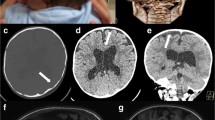Abstract
Introduction
During the last decades, computed tomography (CT) has become the predominant imaging technique in the diagnosis of craniosynostosis. In most craniofacial centers, at least one three-dimensional (3D) computed tomographic scan is obtained in every case of suspected craniosynostosis. However, with regard to the risk of radiation exposure particularly in young infants, CT scanning and even plain radiography should be indicated extremely carefully.
Material and methods
Our current diagnostic protocol in the management of single-suture craniosynostosis is mainly based on careful clinical examination with regard to severity and degree of the abnormality and on ophthalmoscopic surveillance. Imaging techniques consist of ultrasound examination in young infants while routine plain radiographs are usually postponed to the date of surgery or the end of the first year. CT and magnetic resonance imaging (MRI) are confined to special diagnostic problems rarely encountered in isolated craniosynostosis. The results of this approach were evaluated retrospectively in 137 infants who were referred to our outpatient clinic for evaluation and/or treatment of suspected single suture craniosynostosis or positional deformity during a 2-year period (2008–2009).
Results
In 133 (97.1%) of the 137 infants, the diagnosis of single-suture craniosynostosis (n = 110) or positional plagiocephaly (n = 27) was achieved through clinical analysis only. Two further cases were classified by ultrasound, while the remaining two cases needed additional digital radiographs. In no case was CT scanning retrospectively considered necessary for establishing the diagnosis. Yet in 17.6% of cases, a cranial CT scan had already been performed elsewhere (n = 16) or had been definitely scheduled (n = 8).
Conclusion
CT scanning is rarely necessary for evaluation of single-suture craniosynostosis. Taking into account that there is a quantifiable risk of developing cancer in further lifetime, every single CT scan should be carefully indicated.





Similar content being viewed by others
References
Bernier MO, Rehel JL, Brisse HJ, Wu-Zhou X, Caer-Lorho S, Jacob S, Chateil JF, Aubert B, Laurier D (2012) Radiation exposure from CT in early childhood: a French large-scale multicentre study. Br J Radiol 85:53–60
Berrington de González A, Darby S (2004) Risk of cancer from diagnostic X-rays: estimates for the UK and 14 other countries. Lancet 363:345–351
Brenner D, Elliston C, Hall E, Berdon W (2001) Estimated risks of radiation-induced fatal cancer from pediatric CT. AJR Am J Roentgenol 176:289–296
Brenner D, Hall E (2007) Computed tomography—an increasing source of radiation exposure. N Engl J Med 357:2277–2284
Chadwick K, Leenhouts H (2002) What can we say about the dose–effect relationship at very low dose? J Radiol Prot 22:A155–A158
Cinalli G, Spennato P, Sainte-Rose C, Arnaud E, Aliberti F, Brunelle F, Cianciulli E, Renier D (2005) Chiari malformation in craniosynostosis. Childs Nerv Syst 21:889–901
Collmann H, Soerensen N, Krauss J (1999) Craniosynostosis. Treatment, results and complications. Churchill-Livingstone, London
David JD, Poswillo D, Simpson D (1982) The craniosynostoses: Causes, natural history, and management. Springer Verlag, Berlin
Doll R, Peto R (1981) The causes of cancer: quantitative estimates of avoidable risks of cancer in the United States today. J Natl Cancer Inst 66:1191–1308
Domeshek L, Mukundan SJ, Yoshizumi T, Marcus J (2009) Increasing concern regarding computed tomography irradiation in craniofacial surgery. Plast Reconstr Surg 123:1313–1320
Fearon J, Singh D, Beals S, Yu J (2007) The diagnosis and treatment of single-sutural synostoses: are computed tomographic scans necessary? Plast Reconstr Surg 120:1327–1331
Furuya Y, Edwards M, Alpers C, Tress B, Ousterhout D, Norman D (1984) Computerized tomography of cranial sutures: Part 1. Comparison of suture anatomy in children and adults. J Neurosurg 61:53–58
Huda W (2004) Assessment of the problem: pediatric doses in screen-film and digital radiography. Pediatr Radiol 34(Suppl 3):S173–182, discussion S234–S141
Jaffurs D, Denny A (2009) Diagnostic pediatric computed tomographic scans of the head: actual dosage versus estimated risk. Plast Reconstr Surg 124:1254–1260
Panchal J, Uttchin V (2003) Management of craniosynostosis. Plast Reconstr Surg 111:2032–2048, quiz 2049
Regelsberger J, Delling G, Helmke K, Tsokos M, Kammler G, Kränzlein H, Westphal M (2006) Ultrasound in the diagnosis of craniosynostosis. J Craniofac Surg 17:623–625, discussion 626–628
Robinson S, Proctor M (2009) Diagnosis and management of deformational plagiocephaly. J Neurosurg Pediatr 3:284–295
Seibert J (2004) Tradeoffs between image quality and dose. Pediatr Radiol 34(Suppl 3):S183–S195, discussion S234–S141
Soboleski D, McCloskey D, Mussari B, Sauerbrei E, Clarke M, Fletcher A (1997) Sonography of normal cranial sutures. AJR Am J Roentgenol 168:819–821
Soboleski D, Mussari B, McCloskey D, Sauerbrei E, Espinosa F, Fletcher A (1998) High-resolution sonography of the abnormal cranial suture. Pediatr Radiol 28:79–82
Sze R, Parisi M, Sidhu M, Paladin A, Ngo A, Seidel K, Weinberger E, Ellenbogen R, Gruss J, Cunningham M (2003) Ultrasound screening of the lambdoid suture in the child with posterior plagiocephaly. Pediatr Radiol 33:630–636
Thompson DN, Hayward RD (1999) Craniosynostosis—pathophysiology, clinical presentation and investigation. Churchill-Livingstone, London
Conflict of interest
The authors declare that they have no conflict of interest.
Author information
Authors and Affiliations
Corresponding author
Rights and permissions
About this article
Cite this article
Schweitzer, T., Böhm, H., Meyer-Marcotty, P. et al. Avoiding CT scans in children with single-suture craniosynostosis. Childs Nerv Syst 28, 1077–1082 (2012). https://doi.org/10.1007/s00381-012-1721-0
Received:
Accepted:
Published:
Issue Date:
DOI: https://doi.org/10.1007/s00381-012-1721-0




